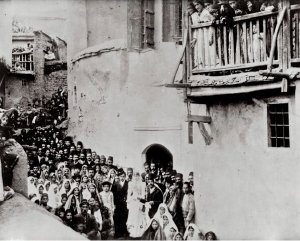These photographs collected from Armenian individuals and families illustrate life from the 1860s through the 1950s. Providing testimony of resilience of the Armenians even as the Genocide 1915-1923 attempted to annihilate their existence. The photographs show villages' resistance efforts, and individuals enlisting in foreign armies to fight against the Turkish perpetrators. In the aftermath of the Genocide, the photographs show rebuilding and thriving families and communities. The Armenians are a people whose history dates back thousands of years. Located at the crossroads of Europe and Asia, invaded and ruled by foreign empires, the Armenians have kept their language, culture and Christian faith through the millennia. In the late 19th century, Armenians began to demand greater freedom and rights while living under the crumbling Ottoman Empire. Under the guise of WWI, the new regime of the Young Turks systematically killed the Armenian male population particularly the leaders and influencers and drove the remaining souls from their homes and their lands into the Syrian Desert, 1.5 million perished. As Armenians fled into exile and ultimately resettled around the world, they created a diaspora, establishing churches, schools, and business while contributing to society in their adopted homes. Project SAVE's collection of photographs chronicles the life and culture of the Armenian people from the 1860s through today, all over the world including the Ottoman, Russian and Persian empires, the Soviet Republic of Armenia as well as in today's Republic of Armenia, and in the Armenian Diaspora created in the wake of the Armenian Genocide.
